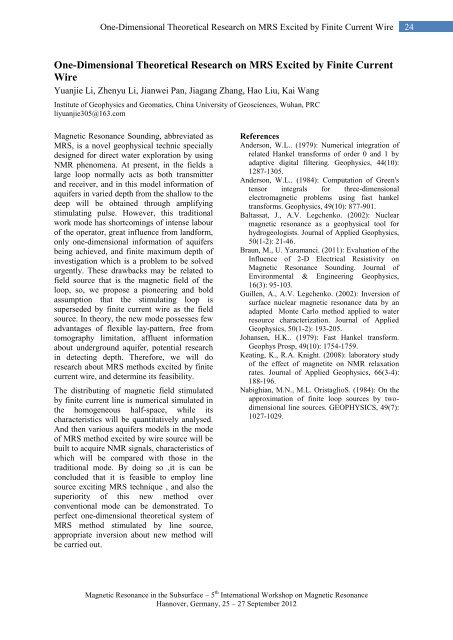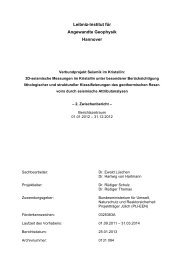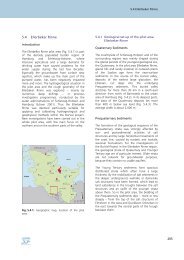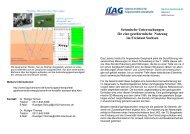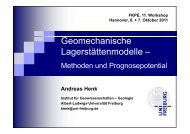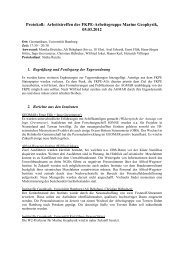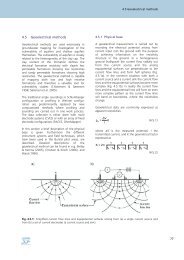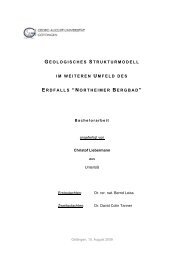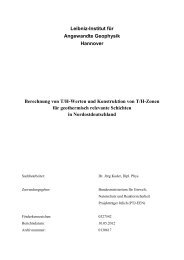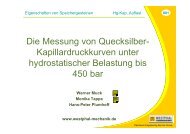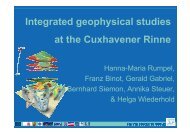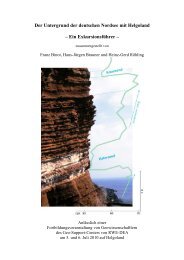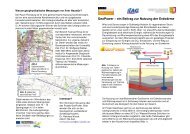Magnetic Resonance in the Subsurface – 5th International ... - LIAG
Magnetic Resonance in the Subsurface – 5th International ... - LIAG
Magnetic Resonance in the Subsurface – 5th International ... - LIAG
Create successful ePaper yourself
Turn your PDF publications into a flip-book with our unique Google optimized e-Paper software.
One-Dimensional Theoretical Research on MRS Excited by F<strong>in</strong>ite Current Wire<br />
One-Dimensional Theoretical Research on MRS Excited by F<strong>in</strong>ite Current<br />
Wire<br />
Yuanjie Li, Zhenyu Li, Jianwei Pan, Jiagang Zhang, Hao Liu, Kai Wang<br />
Institute of Geophysics and Geomatics, Ch<strong>in</strong>a University of Geosciences, Wuhan, PRC<br />
liyuanjie305@163.com<br />
<strong>Magnetic</strong> <strong>Resonance</strong> Sound<strong>in</strong>g, abbreviated as<br />
MRS, is a novel geophysical technic specially<br />
designed for direct water exploration by us<strong>in</strong>g<br />
NMR phenomena. At present, <strong>in</strong> <strong>the</strong> fields a<br />
large loop normally acts as both transmitter<br />
and receiver, and <strong>in</strong> this model <strong>in</strong>formation of<br />
aquifers <strong>in</strong> varied depth from <strong>the</strong> shallow to <strong>the</strong><br />
deep will be obta<strong>in</strong>ed through amplify<strong>in</strong>g<br />
stimulat<strong>in</strong>g pulse. However, this traditional<br />
work mode has shortcom<strong>in</strong>gs of <strong>in</strong>tense labour<br />
of <strong>the</strong> operator, great <strong>in</strong>fluence from landform,<br />
only one-dimensional <strong>in</strong>formation of aquifers<br />
be<strong>in</strong>g achieved, and f<strong>in</strong>ite maximum depth of<br />
<strong>in</strong>vestigation which is a problem to be solved<br />
urgently. These drawbacks may be related to<br />
field source that is <strong>the</strong> magnetic field of <strong>the</strong><br />
loop, so, we propose a pioneer<strong>in</strong>g and bold<br />
assumption that <strong>the</strong> stimulat<strong>in</strong>g loop is<br />
superseded by f<strong>in</strong>ite current wire as <strong>the</strong> field<br />
source. In <strong>the</strong>ory, <strong>the</strong> new mode possesses few<br />
advantages of flexible lay-pattern, free from<br />
tomography limitation, affluent <strong>in</strong>formation<br />
about underground aquifer, potential research<br />
<strong>in</strong> detect<strong>in</strong>g depth. Therefore, we will do<br />
research about MRS methods excited by f<strong>in</strong>ite<br />
current wire, and determ<strong>in</strong>e its feasibility.<br />
The distribut<strong>in</strong>g of magnetic field stimulated<br />
by f<strong>in</strong>ite current l<strong>in</strong>e is numerical simulated <strong>in</strong><br />
<strong>the</strong> homogeneous half-space, while its<br />
characteristics will be quantitatively analysed.<br />
And <strong>the</strong>n various aquifers models <strong>in</strong> <strong>the</strong> mode<br />
of MRS method excited by wire source will be<br />
built to acquire NMR signals, characteristics of<br />
which will be compared with those <strong>in</strong> <strong>the</strong><br />
traditional mode. By do<strong>in</strong>g so ,it is can be<br />
concluded that it is feasible to employ l<strong>in</strong>e<br />
source excit<strong>in</strong>g MRS technique , and also <strong>the</strong><br />
superiority of this new method over<br />
conventional mode can be demonstrated. To<br />
perfect one-dimensional <strong>the</strong>oretical system of<br />
MRS method stimulated by l<strong>in</strong>e source,<br />
appropriate <strong>in</strong>version about new method will<br />
be carried out.<br />
References<br />
Anderson, W.L.. (1979): Numerical <strong>in</strong>tegration of<br />
related Hankel transforms of order 0 and 1 by<br />
adaptive digital filter<strong>in</strong>g. Geophysics, 44(10):<br />
1287-1305.<br />
Anderson, W.L.. (1984): Computation of Green's<br />
tensor <strong>in</strong>tegrals for three-dimensional<br />
electromagnetic problems us<strong>in</strong>g fast hankel<br />
transforms. Geophysics, 49(10): 877-901.<br />
Baltassat, J., A.V. Legchenko. (2002): Nuclear<br />
magnetic resonance as a geophysical tool for<br />
hydrogeologists. Journal of Applied Geophysics,<br />
50(1-2): 21-46.<br />
Braun, M., U. Yaramanci. (2011): Evaluation of <strong>the</strong><br />
Influence of 2-D Electrical Resistivity on<br />
<strong>Magnetic</strong> <strong>Resonance</strong> Sound<strong>in</strong>g. Journal of<br />
Environmental & Eng<strong>in</strong>eer<strong>in</strong>g Geophysics,<br />
16(3): 95-103.<br />
Guillen, A., A.V. Legchenko. (2002): Inversion of<br />
surface nuclear magnetic resonance data by an<br />
adapted Monte Carlo method applied to water<br />
resource characterization. Journal of Applied<br />
Geophysics, 50(1-2): 193-205.<br />
Johansen, H.K.. (1979): Fast Hankel transform.<br />
Geophys Prosp, 49(10): 1754-1759.<br />
Keat<strong>in</strong>g, K., R.A. Knight. (2008): laboratory study<br />
of <strong>the</strong> effect of magnetite on NMR relaxation<br />
rates. Journal of Applied Geophysics, 66(3-4):<br />
188-196.<br />
Nabighian, M.N., M.L. OristaglioS. (1984): On <strong>the</strong><br />
approximation of f<strong>in</strong>ite loop sources by twodimensional<br />
l<strong>in</strong>e sources. GEOPHYSICS, 49(7):<br />
1027-1029.<br />
<strong>Magnetic</strong> <strong>Resonance</strong> <strong>in</strong> <strong>the</strong> <strong>Subsurface</strong> <strong>–</strong> 5 th <strong>International</strong> Workshop on <strong>Magnetic</strong> <strong>Resonance</strong><br />
Hannover, Germany, 25 <strong>–</strong> 27 September 2012<br />
24


